Promising results of Leuven's new circulation plan
A division of the city into different parts, cutting some inner-city street connections to avoid through-traffic and redirecting cars to the city's ring road instead, create more space for pedestrians, cyclists and green areas in the centre.
Both in May 2016 and May 2017, traffic counts took place at 70 different locations within the inner-city and on the ring road, which revealed the following significant figures:
On an average work day, there is:
- 26 % more cycle traffic on the ring road
- 32 % more cycle traffic in the inner city
- 8 % less car traffic in the inner city
- 9 % more car traffic on the ring road
The ratio cycle versus car traffic in the inner city on an average work day has also changed from 33% of cyclists versus 63% cars in 2016 to 41% of cyclists versus 54% cars in 2017. On the ring road they saw 7 % cyclists versus 86 % cars in 2016 while in 2017 this is 9 % cyclists versus 85 % cars. The capacity of the ring road was not exceeded, while some cross roads are quite busy. The number of pedestrians remained stable.
Bus use has increased with 11,7 % and then number of in and out movements in public car parks increased with 8% while search traffic for on-street parking decreased.
The results illustrate that the new circulation plan is paving the way towards a more liveable and accessible Leuven. The main principles of the adopted approach will therefore be maintain, while the city still envisages some changes in the circulation of traffic, the redesign of streets and squares, as well as some additional measures.
